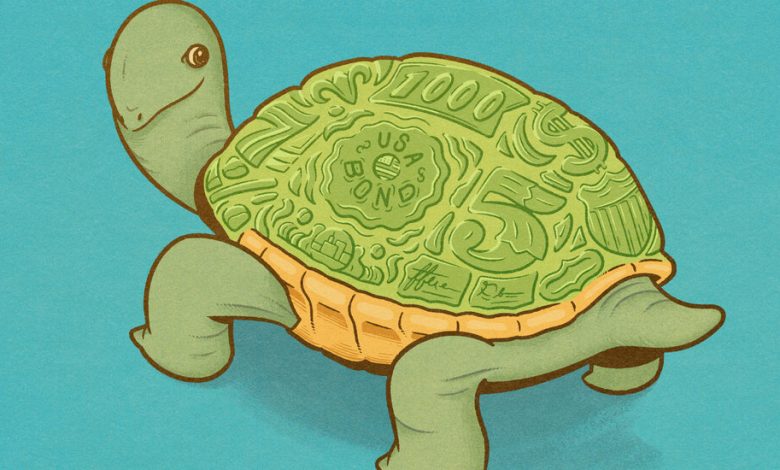Consider Bonds

Give the stock market half a chance and it will dominate the financial headlines. That was certainly the case for the month of July, with the S&P 500 powering upward and bonds barely treading water.
But August has been different, with the stock market hitting a speed bump and the bond market getting attention for an unwelcome reason: a downgrade of U.S. Treasury debt by the Fitch Ratings agency. Fitch says the deterioration in political consensus and the increasing debt levels of the United States mean that it no longer ranks unequivocally as among the safest places to invest in the world.
That’s significant. Because the enduring appeal of bonds comes from their relative safety — and not from spectacular gains and losses that define the stock market’s flamboyant brand — the Fitch downgrade can’t be easily dismissed.
Yet it makes sense to hold U.S. debt anyway, despite tremors in the bond market. You may not think much about bonds, but there’s a good chance that you have a stake in them, if only indirectly: through a fund, especially in a workplace defined-contribution retirement account, like a 401(k), or through a pension or an annuity.
Because bonds are so often overlooked, it’s worth going over some basics.
Stocks vs. Bonds
Stocks are inherently speculative. They provide fractional ownership of a company and are a bet that the value of your shares will appreciate. Often, you get dividends, but a company isn’t required to pay them.
Bonds, on the other hand, are a loan to a company or a government, like the United States, which is generally obligated to pay you interest and, at a certain date, repay your principal, too. Should a company — or a country — run into financial trouble, bondholders customarily have high status among creditors. These features typically make bonds less risky than stocks.
But bonds contain a speculative element, too. Even the safest bonds do.
The conventional wisdom is that U.S. Treasuries are the safest bonds, a claim that has given them an exalted status as the benchmark from which all other asset values may be measured. The “risk-free” rate provided by Treasuries is used in finance as the hurdle that every other investment — a stock or a capital project or a buyout of a private company — must clear to be deemed even minimally viable as a place to put your money.
U.S. Treasuries constitute an extraordinarily deep and nimble $25.1 trillion market. It’s no exaggeration to say that the entire world’s financial system is based on U.S. Treasuries, and calibrated against Treasury rates.
That’s still the case. But it’s difficult to assert with a straight face that U.S. Treasuries are really risk free — not after the losses in the bond market last year, or the “perils-of-Pauline” brushes with disaster in multiple debt ceiling crises. The Fitch debt downgrade is a reasonable response to those crises.
Interest Rate Risk
Investors in high-quality bonds, and, especially, Treasuries, face two significant problems: interest rate risk and credit risk.
To understand interest rate risk, recall that bond prices and interest rates (a.k.a. yields)move in opposite directions. That’s how bonds work. In 2013, when it looked like rates were rising, the Securities and Exchange Commission issued a bulletin on interest rate risk, which I thought was particularly apt, comparing bond prices and interest rates to the two ends of a playground seesaw (or teeter-totter, if you’re from the Midwest). When one side rises, the other falls. Every child in the playground learns that soon enough. Bond investors do, too.
Last year, the seesaw crashed. Because of soaring inflation and the Federal Reserve’s effort to curb it by raising short-term rates, bond market rates rose and prices plummeted. It was the worst year for bond investors since the 1920s, and, probably much longer, as I wrote in late 2022.
But now, with yields already much higher than they have been over most of the past decade — most rose a bit after a government report on Thursday showed that core inflation was still sizzling at 4.7 percent a year — a repetition of last year’s severe bond losses is extremely unlikely.
Yes, yields could still rise further if inflation remains high, and that could lead to modest short-term losses in bond funds or, if you trade them, in individual bonds. That’s especially true for bonds with longer maturities.
Inflation’s not the only problem. The U.S. Treasury is pouring new debt into the market while the Fed, which had been the biggest domestic purchaser of Treasuries, has gotten out of that game as it tightens financial conditions to fight inflation. The appetites of China and Japan, big foreign buyers of Treasuries, may be diminishing. These incremental shifts in supply and demand may well increase rates marginally and depress prices.
All of this is why money market funds — which track interest rate shifts closely and do not decline in price when yields rise — may be a better short-term bet than bonds for the next month or two, with money-market yields well above 5 percent.
Even so, with the benchmark 10-year Treasury already above 4 percent, bond yields are high enough to provide a buffer and substantial enough for high-quality bonds to perform their traditional functions: generating income and providing a counterweight to stocks.
But that brings us to credit risk and the Fitch downgrade.
What About the Downgrade?
High-yield bonds self-evidently entail credit risk. They are called junk bonds for a reason. Companies are forced to pay higher yields precisely because of the risk that they won’t make good on their debt. If you can accept the risk and do some research — or have a prudent manager do it for you — junk bonds can be lucrative, much like stocks.
But I’m focusing here on using bonds for their traditional purpose as a relatively stable income provider, offsetting the volatility of stocks. Investment grade bonds, either corporate or government, are good choices. (Inflation-adjusted bonds and municipal bonds can be worthwhile, too, but I’ll discuss them another day.)
The safest of U.S. bonds are still Treasuries, in my view, though Microsoft and Johnson & Johnson bonds have higher credit ratings. But would those companies be great credit risks if the U.S. government defaulted on its debt? I have my doubts.
Many countries now have better credit ratings than the United States, including Australia, Denmark, Germany, Norway, Singapore, Sweden and Switzerland. The United States still has a pristine grade from Moody’s. Standard & Poor’s downgraded U.S. debt one notch in 2011 and Fitch followed suit this month. I fully expect Moody’s to do the same one day, if the United States continues to flirt with debt default.
The issue is governance, not financial stress. As Jamie Dimon, the chief executive of JPMorgan Chase, says, the United States remains the most powerful economy and country in the world. The global bond market is willing and able to absorb all of the debt that is being issued by the U.S. Treasury.
Yet the core problem is profound. The political system in the United States has become sufficiently dysfunctional that fiscal policy is an exercise in brinkmanship. The specter of a debt default is no longer unthinkable. How much money the United States should spend and how much it should raise through taxation — and by taxing whom, exactly — have always been difficult issues. But bipartisan compromises have become rare achievements in Washington.
If Fitch didn’t provide new information, it set off a warning flag.
U.S. credit is still strong, though not as great as it was. Treasuries remain essential in nearly everyone’s portfolio. But until a semblance of consensus on fiscal matters is restored, the world will be bearing unnecessary risk.





